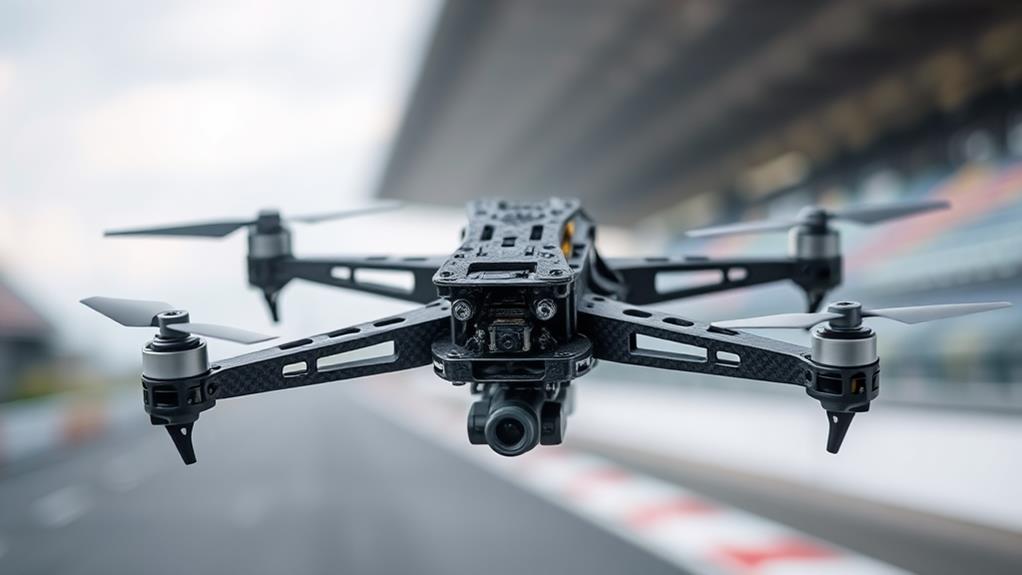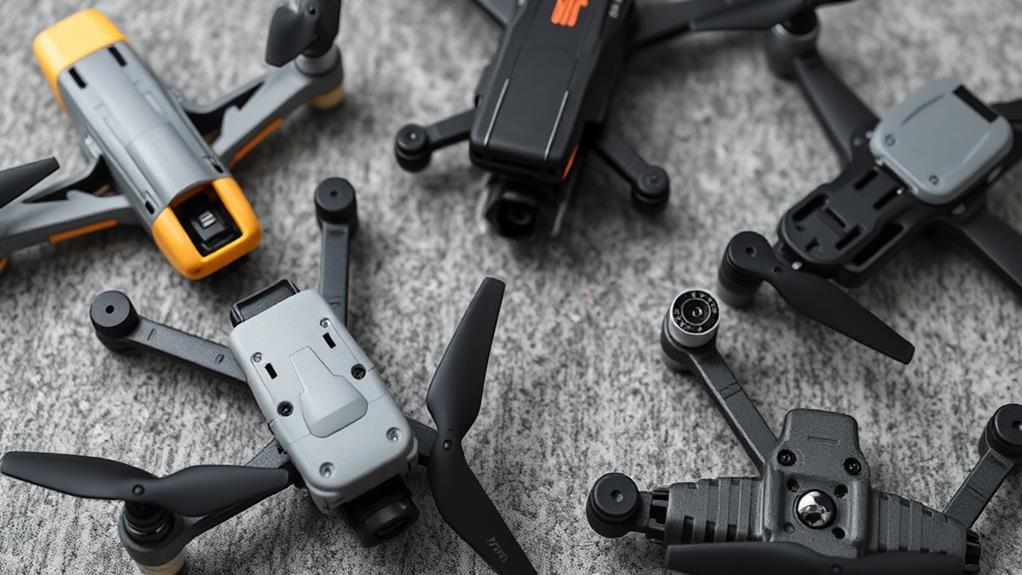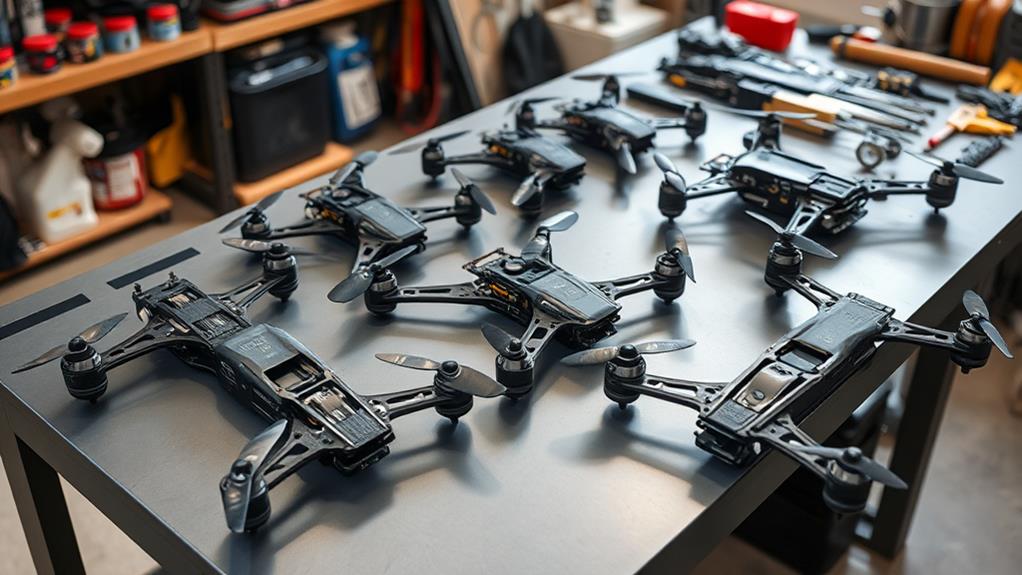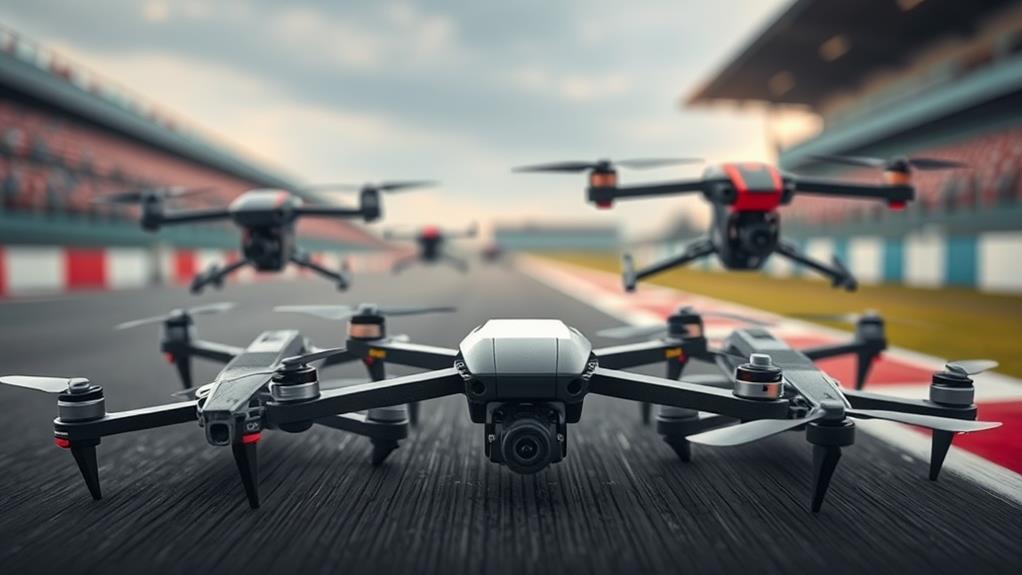The right racing drone frame is essential because it directly affects your drone's speed, agility, and overall performance. Frame size influences propeller compatibility and thrust; smaller frames enhance agility, while larger frames offer stability. Material matters too—strong and lightweight carbon fiber frames are preferred for their durability and performance. Additionally, different frame types, like H or True-X frames, provide varying stability and handling characteristics. Choosing wisely guarantees not only better race results but also long-term value and ease of maintenance. Understanding these factors will help you make an informed choice and elevate your racing experience.
Importance of Frame Selection

Choosing the right racing drone frame is essential for maximizing your drone's performance. When selecting a frame, you must evaluate its impact on agility and speed. High-powered brushless motors and tuned electronic speed controllers (ESCs) can further enhance these attributes, making frame selection even more important for achieving ideal performance in racing.
X-type frames are often the popular choice for their lightweight design and responsive handling, making them an important factor to evaluate for any racer. The frame size, which is measured by the diagonal motor-to-motor distance, also plays a considerable role. Larger frames can accommodate bigger props, enhancing thrust and overall performance, especially when paired with an exceptional first-person view (FPV) system.
Material choice is another critical aspect; carbon fiber frames offer an impressive strength-to-weight ratio. This means you can enjoy a lightweight drone without sacrificing durability. Additionally, the design of the frame—whether it's a True-X or Stretch-X configuration—affects your drone's center of gravity and stability. These elements are essential for maintaining control during high-speed maneuvers, especially in competitive racing.
A well-chosen frame can greatly reduce the risk of crashes and damage, ensuring the longevity and reliability of your drone. Ultimately, investing time in selecting the right frame enhances your overall racing experience, allowing you to focus on what matters most—speed and agility.
Impact on Performance
The performance of your racing drone hinges considerably on the frame you select. The frame size, typically ranging from 150mm to 250mm, dictates the size of props you can use, which directly impacts thrust and overall flight performance. Understanding the categories of racing drones is crucial to make an informed choice.
If you opt for a lighter frame, you'll benefit from enhanced agility and responsiveness—important traits for making quick directional changes during competitive races. Conversely, heavier frames may offer stability, but at the expense of speed.
Your choice between X frames and H frames also plays a significant role. Generally, X frames are favored for their superior speed and agility, making them a popular choice among racers. The design of the frame, including arm spacing, influences aerodynamics too.
Wider X frames, for instance, provide improved pitch and roll sensitivity, aiding advanced flying techniques.
Material selection is another critical factor. Using carbon fiber for frames larger than 3 inches guarantees a high strength-to-weight ratio, which is essential for maintaining performance during high-speed races and potential impacts.
Ultimately, the right frame can elevate your racing experience, allowing you to navigate courses faster and more efficiently.
Frame Types for Racing

When choosing a racing drone frame, you'll encounter different types, each with unique advantages.
For instance, H frames offer sturdy construction and stability, while True-X frames provide a balanced handling experience that's ideal for sharp turns.
Additionally, the choice of frame impacts the overall weight and aerodynamics of the drone, influencing its speed and agility during races.
Understanding these frame types will help you select the best option for your racing needs, ensuring peak performance and compliance with FAA regulations.
H Frame Advantages
Many racing drone enthusiasts prefer H frames for their excellent balance of stability and durability. The perpendicular arms of an H frame create a spacious body that accommodates essential electronics, making it ideal for precise component arrangement vital for high-performance racing.
This design enhances stability in flight, allowing you to navigate high-speed maneuvers smoothly, which can be a game changer during competitive events. With the right frame, pilots can execute advanced techniques like the Power Loop with greater ease and control, showcasing their skill during races.
Another significant advantage of H frames is their durability. With a larger surface area, they can better absorb impacts from crashes, ensuring your racing drone is more resilient than others.
This durability translates to a longer lifespan, reducing the need for constant repairs or replacements.
Moreover, H frames offer easy access to components, which is essential for quick repairs and modifications during races. When you're in a high-pressure situation, being able to access and replace parts swiftly can make all the difference in maintaining your competitive edge.
True-X Frame Benefits
While H frames offer stability and durability, True-X frames bring their own set of advantages that cater to racing enthusiasts. The symmetrical design of True-X frames, with arms intersecting at the center, allows for balanced handling and stability, which is vital during high-speed maneuvers. This design guarantees an equal distribution of forces, enhancing your drone's responsiveness for quick directional changes.
True-X frames typically support larger propeller sizes, markedly improving thrust and aiding in faster acceleration, essential for competitive performance. The aerodynamics of these frames minimize drag, enabling you to achieve higher speeds while maintaining stability and control throughout the race course.
Additionally, the low center of gravity in True-X frames improves flight characteristics, making them particularly suited for racing applications where agility and precision are paramount.
You'll find that these frames not only provide a solid support system but also enhance your overall racing experience. By choosing a True-X frame, you're setting yourself up for success in the fast-paced world of drone racing, where every advantage counts.
Embrace the benefits of True-X frames to elevate your racing game.
Material Considerations
Which materials should you prioritize when selecting a racing drone frame? The choice of materials plays a significant role in your drone's performance and durability.
Carbon fiber is the top choice for racing drone frames due to its excellent strength-to-weight ratio. It gives you the durability needed without adding significant weight, which is essential for speed and agility.
On the other hand, aluminum frames are durable but can weigh your drone down, impacting performance. If you opt for aluminum, take into account 6061 or 7075 alloys; 7075 is stronger but heavier and more expensive.
Additionally, using high-strength steel screws, typically graded 10.9 or 12.9, guarantees your frame remains sturdy under racing conditions.
Lastly, lightweight plastics and composite materials may be suitable for smaller racing drones, providing effective impact absorption while keeping weight low, though they may compromise some durability compared to carbon fiber.
Here's a quick summary of materials to take into account:
- Carbon Fiber: Best for strength and minimal weight.
- Aluminum Frames: Good durability, but heavier.
- High-Strength Steel Screws: Essential for structural integrity.
- Lightweight Plastics: Great for impact absorption, but less durable.
Size and Weight Factors

Selecting the right size and weight for your racing drone frame is fundamental for maximizing performance. The size, measured by the diagonal distance between motor midpoints, dictates the maximum propeller size your frame can support. For instance, frames under 200mm typically accommodate props up to 4 inches.
On the other hand, weight plays an essential role in a drone's responsiveness. Heavier frames may enhance durability and crash resistance, but they can reduce flight time and agility, which are crucial in racing.
Ideally, your racing drone frame should weigh under 250 grams to maintain agility and comply with regulatory standards. Lighter designs favor performance without compromising stability. The arm length also influences maneuverability; shorter arms improve agility, while longer arms can support larger props for better lift, potentially hindering quick directional changes.
Moreover, optimal weight distribution is critical, as excess weight can lead to increased power consumption and decreased flight performance. This balance impacts your competitive racing outcomes.
Long-term Value and Durability
When it comes to racing drones, durability and long-term value are essential considerations that can save you both time and money. A durable racing drone frame crafted from high-quality materials, such as carbon fiber, can greatly extend your drone's lifespan. You won't need to replace it as often after crashes, which is a major advantage.
Choosing the right frame involves looking for features that enhance crash resistance and repairability, including:
- Thicker carbon fiber frames (5-6 mm) for improved durability
- Lifetime warranties that indicate a commitment to quality
- Designs with replaceable arms for easy repairs
- Regular maintenance to maximize the frame's lifespan
Investing in a reliable FPV drone frame can lead to considerable cost savings over time.
Frames designed with replaceable arms allow for quick fixes after accidents, rather than forcing you to buy an entirely new frame.
Additionally, evaluating user reviews and understanding the crash history of a frame will help you gauge its long-term value.
With the right approach, you'll not only enjoy racing but also make certain your investment stands the test of time.
Conclusion
Choosing the right racing drone frame isn't just a matter of preference; it's essential for your overall success on the track. The frame affects everything from agility to durability, helping you navigate twists and turns with ease. By understanding the various frame types, materials, and sizes, you can make an informed decision that enhances your performance. Investing in the right frame translates to better control and longevity, ensuring you're not just flying, but soaring above the competition.

Leave a Reply